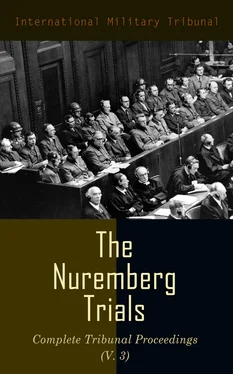On the 2d of September 1939, the day after he had invaded Poland and occupied Danzig, he again expressed his determination, so he said, to observe the inviolability and integrity of Norway in an aide-mémoire, which was handed to the Norwegian Foreign Minister by the German Minister in Oslo on that day.
A month later, in a public speech on the 6th of October 1939, he said:
“Germany has never had any conflicts of interest or even points of controversy with the northern states, neither has she any today. Sweden and Norway have both been offered non-aggression pacts by Germany, and have both refused them, solely because they do not feel themselves threatened in any way.”
When the invasion of Denmark and Norway was already begun in the early morning of 9 April 1940, a German memorandum was handed to the governments of those countries attempting to justify the German action. Various allegations against the governments of the invaded countries were made. It was said that Norway had been guilty of breaches of neutrality. It was said that she had allowed and tolerated the use of her territorial waters by Great Britain. It was said that Britain and France were themselves making plans to invade and occupy Norway and that the Government of Norway was prepared to acquiesce in such an event.
I do not propose to argue the question whether or not these allegations were true or false. That question is irrelevant to the issues before this Court. Even if the allegations were true—and they were patently false—they would afford no conceivable justification for the action of invading without warning, without declaration of war, without any attempt at mediation or conciliation.
Aggressive war is none the less aggressive war because the state which wages it believes that other states might, in the future, take similar action. The rape of a nation is not justified because it is thought she may be raped by another. Nor even in self-defense are warlike measures justified except after all means of mediation have been tried and failed and force is actually being exercised against the state concerned.
But the matter is irrelevant because, in actual fact, with the evidence which we now possess, it is abundantly clear that the invasion of these two countries was undertaken for quite different purposes. It had been planned long before any question of breach of neutrality or occupation of Norway by England could ever have occurred. And it is equally clear that the assurances repeated again and again throughout 1939 were made for no other purpose than to lull suspicion in these countries, and to prevent them taking steps to resist the attack against them which was all along in active preparation.
For some years the Defendant Rosenberg, in his capacity as Chief of the Foreign Affairs Bureau—APA—of the NSDAP, had interested himself in the promotion of Fifth Column activities in Norway and he had established close relationship with the Nasjonal Samling, a political group headed by the now notorious traitor, Vidkun Quisling. During the winter of 1938-39, APA was in contact with Quisling, and later Quisling conferred with Hitler and with the Defendants Raeder and Rosenberg. In August 1939 a special 14-day course was held at the school of the Office of Foreign Relations in Berlin for 25 followers whom Quisling had selected to attend. The plan was to send a number of selected and “reliable” men to Germany for a brief military training in an isolated camp. These “reliable men” were to be the area and language specialists to German special troops who were taken to Oslo on coal barges to undertake political action in Norway. The object was a coup in which Quisling would seize his leading opponents in Norway, including the King, and prevent all military resistance from the beginning. Simultaneously with those Fifth Column activities Germany was making her military preparations. On the 2d of September 1939, as I said, Hitler had assured Norway of his intention to respect her neutrality. On 6 October he said that the Scandinavian states were not menaced in any way. Yet on the 3rd October the Defendant Raeder was pointing out that the occupation of bases, if necessary by force, would greatly improve the German strategic position. On the 9th of October Dönitz was recommending Trondheim as the main base, with Narvik as an alternative base for fuel supplies. The Defendant Rosenberg was reporting shortly afterwards on the possibility of a coup d’état by Quisling, immediately supported by German military and naval forces. On the 12th of December 1939 the Defendant Raeder advised Hitler, in the presence of the Defendants Keitel and Jodl, that if Hitler was favorably impressed by Quisling, the OKW should prepare for the occupation of Norway, if possible with Quisling’s assistance, but if necessary, entirely by force. Hitler agreed, but there was a doubt whether action should be taken against the Low Countries or against Scandinavia first. Weather conditions delayed the march on the Low Countries. In January 1940 instructions were given to the German Navy for the attack on Norway. On the 1st of March a directive for the occupation was issued by Hitler. The general object was not said to be to prevent occupation by English forces but, in vague and general terms, to prevent British encroachment in Scandinavia and the Baltic and “to guarantee our ore bases in Sweden and to give our Navy and Air Force a wider start line against Britain.” But the directive went on (and here is the common pattern):
“. . . on principle we will do our utmost to make the operation appear as a peaceful occupation, the object of which is the military protection of the Scandinavian states . . . . It is important that the Scandinavian states as well as the western opponents should be taken by surprise by our measures . . . . In case the preparations for embarkation can no longer be kept secret, the leaders and the troops will be deceived with fictitious objectives.”
The form and success of the invasion are well known. In the early hours of the 9th of April, seven cruisers, 14 destroyers, and a number of torpedo boats and other small craft carried advance elements of six divisions, totalling about 10,000 men, forced an entry and landed troops in the outer Oslo Fjord, Kristiansand, Stavanger, Bergen, Trondheim, and Narvik. A small force of troops was also landed at Arendal and Egersund on the southern coast. In addition, airborne troops were landed near Oslo and Stavanger in airplanes. The German attack came as a complete surprise. All the invaded towns along the coast were captured according to plan and with only slight losses. Only the plan to capture the King and Parliament failed. But brave as was the resistance, which was hurriedly organized throughout the country—nothing could be done in the face of the long-planned surprise attack—and on the 10th of June military resistance ceased. So another act of aggression was brought to completion.
Almost exactly a month after the attack, on Norway, on the 10th of May 1940, the German Armed Forces, repeating what had been done 25 years before, streamed into Belgium, the Netherlands, and Luxembourg according to plan—a plan that is, of invading without warning and without any declaration of war.
What was done was, of course, a breach of the Hague Convention, and is so charged. It was a violation of the Locarno Agreement of 1925, which the Nazi Government affirmed in 1935, only illegally to repudiate it a couple of years later. By that agreement all questions incapable of settlement by ordinary diplomatic means were to be referred to arbitration. You will see the comprehensive terms of all those treaties. It was a breach of the Treaty of Arbitration and Conciliation signed between Germany and the Netherlands on the 20th of May 1926. It was a breach of a similar treaty with Luxembourg of 11 September 1929. It was a breach of the Kellogg-Briand Pact. But those treaties, perhaps, had not derived in the minds of the Nazi rulers of Germany any added sanctity from the fact that they had been solemnly concluded by the governments of pre-Nazi Germany. Let us then consider the specific assurances and undertakings which the Nazi rulers themselves gave to these states which lay in the way of their plans against France and England and which they had always intended to attack. Not once, not twice, but 11 times the clearest possible assurances were given to Belgium, the Netherlands, and Luxembourg. On those assurances, solemnly given and formally expressed, these countries were entitled to rely and did rely. In respect of the breach of those assurances these defendants are charged. On the 30th of January 1937, for instance, Hitler had said:
Читать дальше












